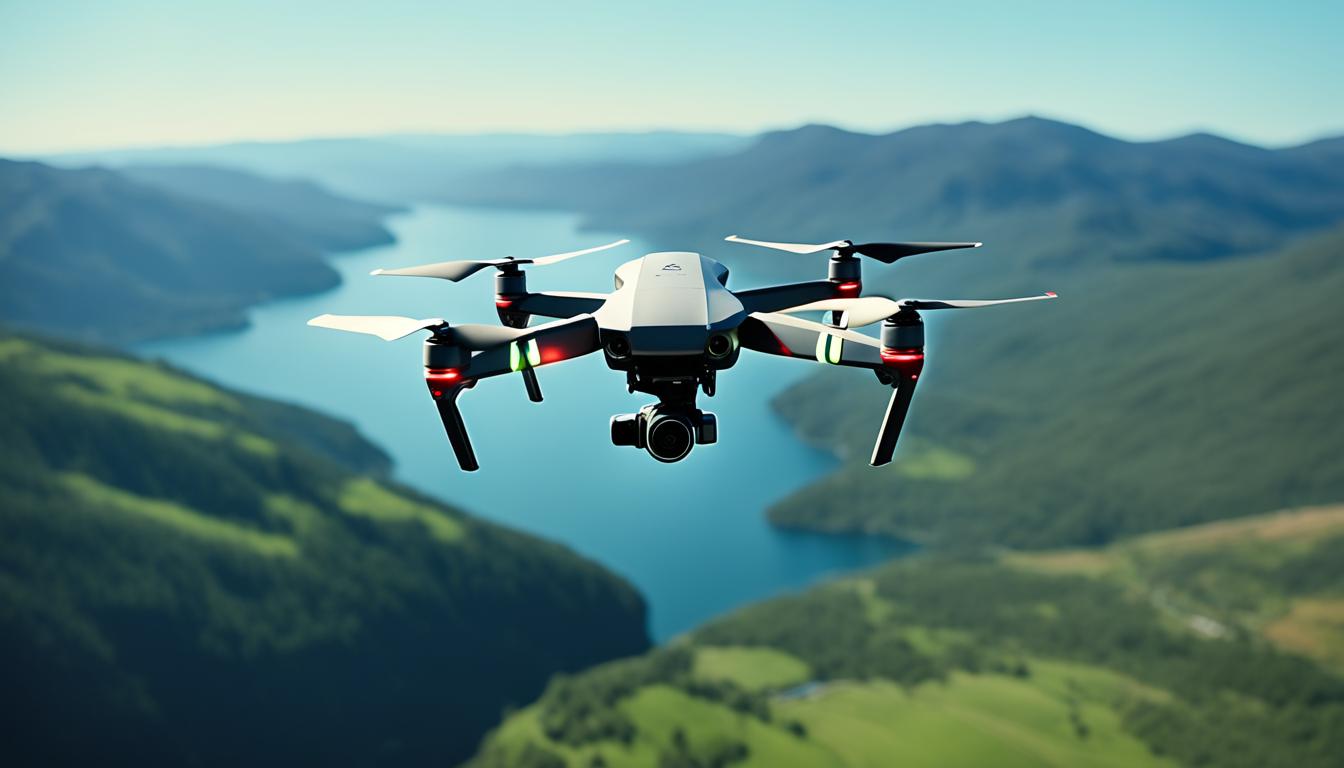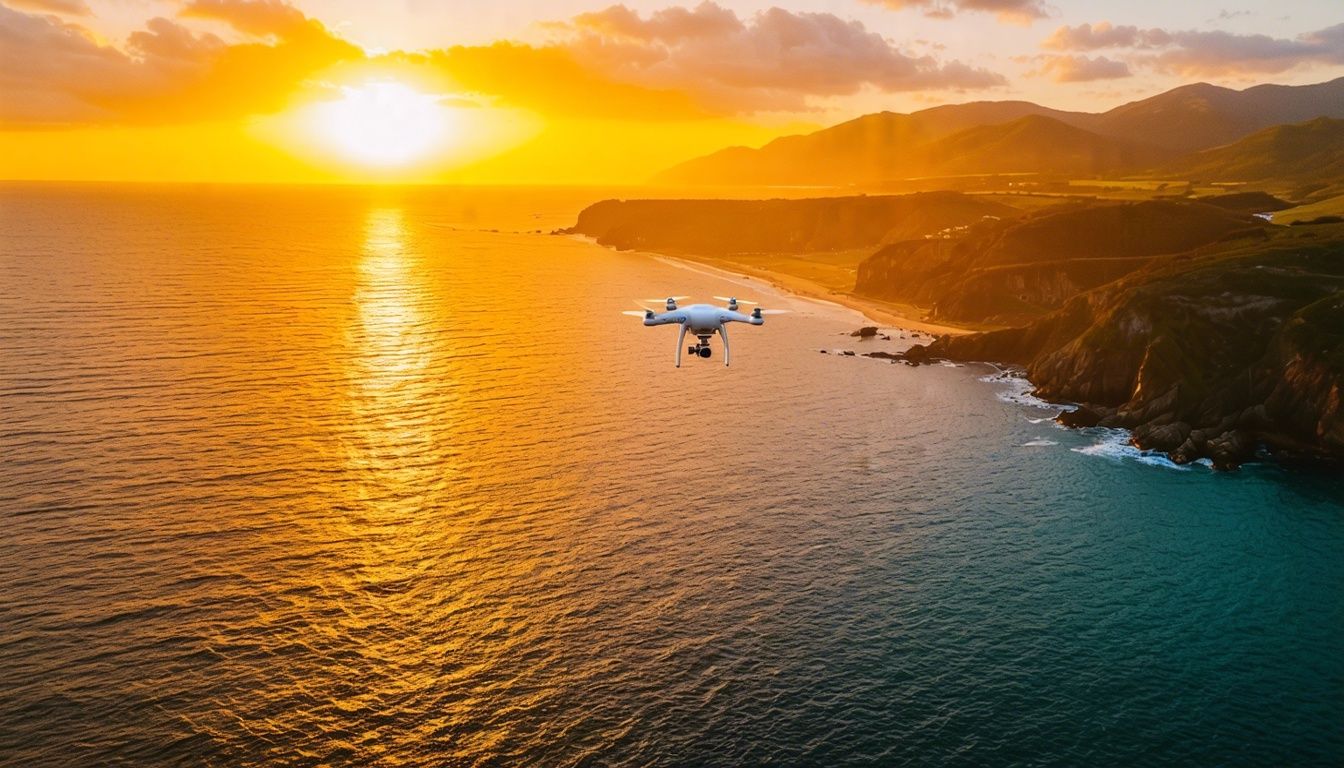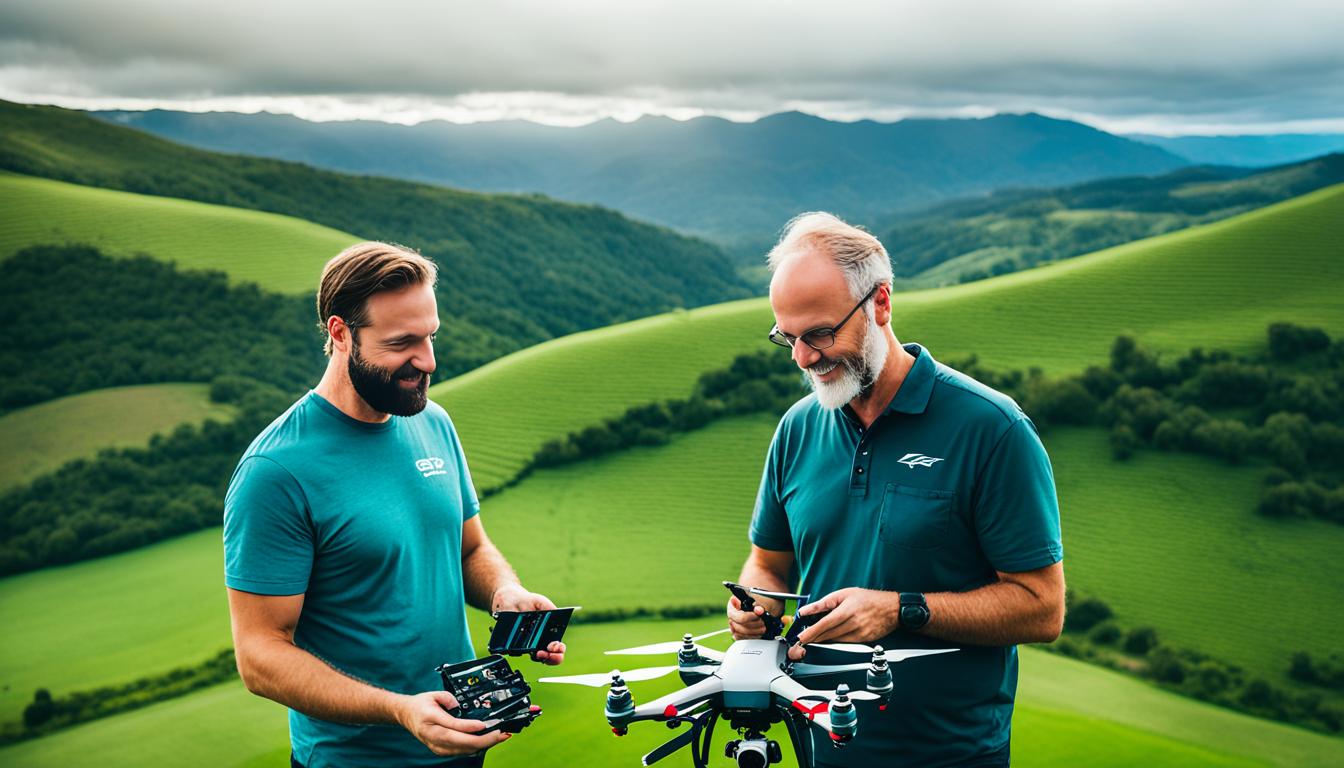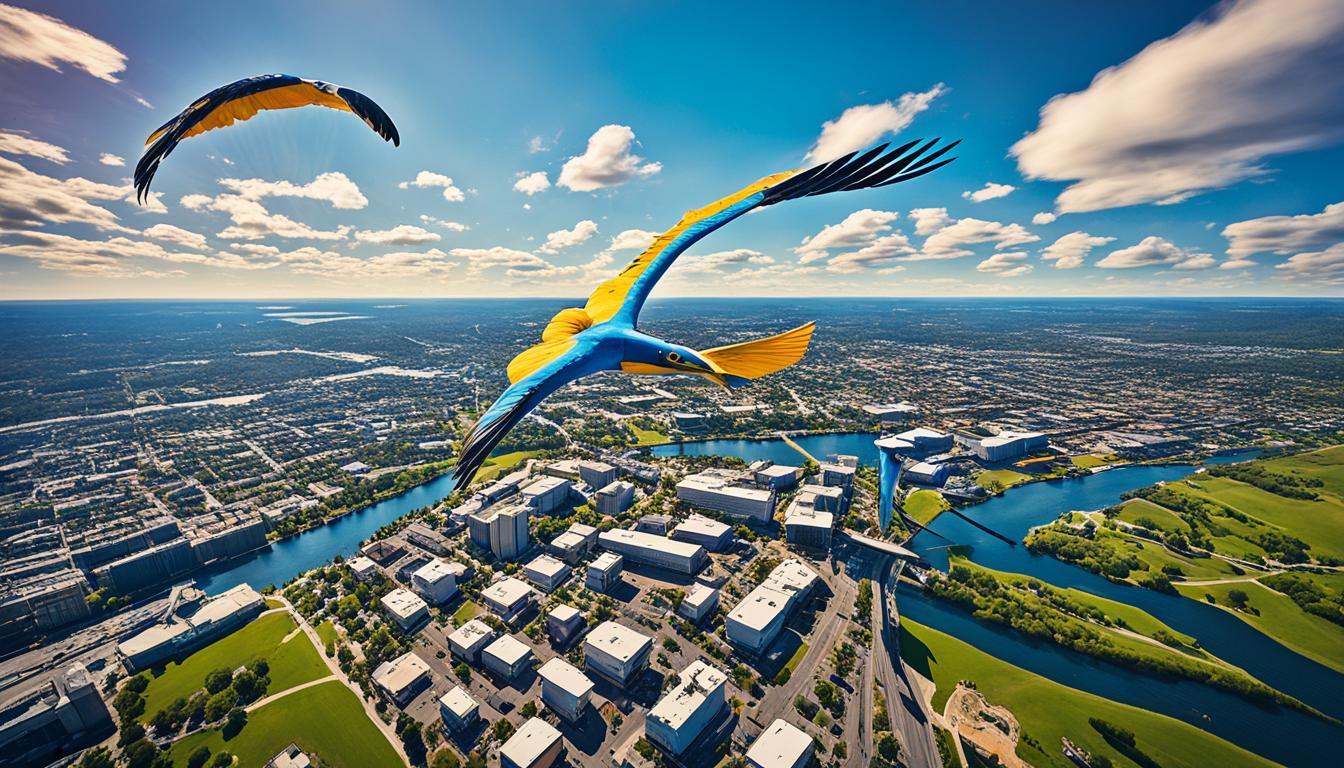Welcome to our guide on drone photography techniques for beginners! Drones have revolutionized the way we capture stunning aerial shots, offering mobility and unique perspectives that were once only possible with expensive equipment. In this guide, we will explore the essential tips and techniques to help you take great drone photos as a beginner.
Before we delve into the details, it’s important to understand that drone photography comes with its own set of challenges. However, with the right knowledge and practice, you can overcome these hurdles and create breathtaking images.
One of the first things to consider as a beginner is the type of drone to invest in. Entry-level drones are available at different price points, and honing your piloting skills can be a better investment than splurging on a professional drone setup. Start with a budget-friendly option and gradually upgrade as you advance in your photography journey.
Another aspect to keep in mind is the camera quality. While drone cameras may not match the image quality of DSLRs, they offer the advantage of mobility and capturing unique aerial perspectives. Understanding the specifications and capabilities of your drone’s camera is crucial for taking the best possible shots.
Weather conditions can also impact your drone photography. It’s important to avoid flying in high winds or cloudy skies, as these factors can affect both the stability of the drone and the quality of your photos. Additionally, always prioritize safety and adhere to the regulations regarding drone flights in your area.
In this guide, we will cover various aspects of drone photography, including composition techniques, piloting skills, editing tips, and more. Whether you’re a novice or have some experience, this guide will provide valuable insights to help you elevate your drone photography skills.
Key Takeaways:
- Invest in a budget-friendly drone to start and focus on honing your piloting skills.
- Understand the specifications and capabilities of your drone’s camera for optimal results.
- Avoid flying in high winds or cloudy conditions, as they can affect stability and image quality.
- Always prioritize safety and follow the regulations regarding drone flights in your area.
- Stay tuned for the upcoming sections where we’ll dive deeper into composition, piloting skills, editing, and more!
The Importance of Image Quality in Drone Photography
When it comes to drone photography, image quality is a crucial factor that photographers must consider. While drone cameras have significantly improved over the years, they still have limitations compared to traditional DSLRs.
Most consumer drones feature cameras with around 20 megapixels and smaller sensors. This means that drone cameras may not deliver the same level of image quality as their DSLR counterparts. However, it’s important to note that image quality is only one aspect of drone photography.
The true value of drone photography lies in the unique perspectives and stunning aerial shots that can be captured. With drones, photographers have the freedom to explore different angles, heights, and locations that were once impossible for traditional photographers.
To make up for any compromise in image quality, drone photographers can employ a few techniques. One strategy is to take multiple shots of the same scene and later merge them using post-processing software like Adobe Lightroom. This technique helps to enhance details, colors, and dynamic range, resulting in high-quality images despite the limitations of drone cameras.
It’s also essential for drone photographers to have a clear understanding of their drone camera’s specifications and capabilities. This includes knowing the megapixel count, sensor size, and other relevant details. By understanding these specifications, photographers can maximize the potential of their drone cameras and utilize them effectively.
While image quality is important in photography, drone photography goes beyond just the technical aspects. It’s about capturing breathtaking moments from a unique perspective and telling stories through aerial imagery. By embracing the mobility and creative possibilities offered by drones, photographers can still achieve exceptional results, even with the limitations in image quality.
Tips for Flying Drones in Different Weather Conditions
When it comes to drone photography, weather conditions can significantly impact the quality of your shots. Whether you’re dealing with high winds, cloudy skies, or other challenging weather conditions, it’s essential to understand how they can affect your drone’s stability and the overall outcome of your photographs. By taking a few precautions and following some essential tips, you can ensure safe drone flights and capture stunning images in a variety of weather conditions.
Flying Drones in High Winds
Flying drones in high winds can be risky and potentially dangerous. Strong gusts of wind can throw your drone off balance, making it difficult to maintain stability and control. To mitigate the risks, consider these tips:
- Check the weather forecast before heading out to ensure that wind speeds are within your drone’s recommended limits.
- Avoid flying your drone in open areas with minimal wind protection, as these locations can amplify wind gusts.
- If you need to fly in windy conditions, fly against the wind for better control and better stability.
- Reduce the drone’s speed and adjust the flight mode to a more stable setting to maintain control.
Drone Photography in Cloudy Conditions
Cloudy conditions can affect the lighting and overall ambiance of your drone photos. While clouds can add drama and texture to your shots, they can also impact the color balance and contrast. Here are some tips to make the most of cloudy conditions:
- Experiment with different exposure settings to compensate for the lack of natural light and ensure proper exposure.
- Consider shooting in RAW format to retain more information in post-processing and make adjustments to the exposure and white balance if needed.
- Look for opportunities to capture unique cloud formations or use the clouds as a backdrop to add depth and dimension to your compositions.
Remember to keep an eye on the weather conditions throughout your flight and be prepared to land if the weather worsens. Safety should always be your top priority when flying drones.
“Understanding the limitations and risks associated with flying drones in different weather conditions is crucial for safe and successful aerial photography.” – Drone Photography Magazine
By familiarizing yourself with the weather conditions and taking necessary precautions, you can ensure safe drone flights and capture breathtaking photographs in various environments. Stay informed, be cautious, and prepare for different weather scenarios to make the most of your drone photography adventures.

Tips for Safe Drone Flights
In addition to weather considerations, here are some general tips to ensure safe drone flights:
- Read and understand your drone’s user manual thoroughly before flying.
- Be aware of and follow the regulations and laws regarding drone flights in your area.
- Respect privacy and avoid flying over private property without permission.
- Before each flight, perform a pre-flight inspection of your drone to ensure it’s in proper working condition.
- Maintain a safe distance from people, buildings, and other aircraft.
By staying informed, prepared, and cautious, you can enhance your drone photography skills and capture stunning aerial images in different weather conditions.
Mastering Drone Piloting Skills
Becoming a skilled drone pilot is crucial for capturing exceptional photos from the air. While learning to operate a drone may seem intimidating at first, it is actually relatively easy to pick up the necessary skills. Our focus is on prioritizing safety and adhering to the regulations set by the Federal Aviation Administration (FAA). By understanding and following the rules, pilots can ensure that their drone flights are safe and compliant with the law.
Learning to Fly a Drone
Learning to fly a drone is an exciting journey that starts with mastering the basic flight controls. Most drones come with user-friendly controllers that allow precise maneuvering in the air. As beginners, it’s essential to practice in open, unobstructed areas to gain familiarity with the controls and build confidence. Gradually, pilots can move on to more advanced maneuvers, such as navigating around obstacles and adjusting altitude and speed.
Drone Flying Regulations
Understanding and complying with drone flying regulations is paramount for responsible and legal drone operations. The FAA has established guidelines to ensure the safety of both pilots and the public. Some key regulations include:
- Flying drones below 400 feet above ground level
- Not operating drones near airports or other restricted airspace
- Avoiding flying drones over crowds or stadiums
- Maintaining visual line of sight with the drone at all times
These regulations are in place to prevent accidents and potential harm to people and property. By following them diligently, pilots can enjoy their drone flights while minimizing risks.
Getting a Pilot’s License for Drones
Pilots who are serious about drone photography and want to take their skills to the next level should consider obtaining a pilot’s license. The FAA offers the Remote Pilot Certificate, also known as Part 107, for commercial drone operations. This certification requires passing a knowledge test that covers topics such as airspace regulations, weather conditions, and emergency procedures. Having a pilot’s license not only demonstrates a commitment to professionalism but also opens up opportunities for commercial drone work.
“Mastering drone piloting skills is the foundation for capturing breathtaking aerial photos. By prioritizing safety, understanding and obeying regulations, and continuously honing our flying abilities, we can elevate the art of drone photography to new heights.”
Now that we’ve covered the importance of mastering drone piloting skills, let’s move on to another crucial aspect of drone photography – the importance of battery life. Ensuring that your drone has enough power to capture stunning shots is essential for maximizing your time in the air.
The Importance of Battery Life in Drone Photography
When it comes to drone photography, one of the key factors that photographers need to consider is the battery life of their drones. The amount of time they can spend capturing breathtaking aerial shots is limited by the battery, which typically lasts around 30 minutes or less. It’s crucial to plan drone flights accordingly and take into account the battery life to make the most of the photography session.
Imagine being in the middle of capturing a stunning landscape or an epic aerial shot, only to have your drone’s battery run out. It can be frustrating and disappointing, not to mention the missed opportunities for capturing those perfect shots. That’s why it’s important to carry extra batteries when you go out for a drone photography session.
Having extra batteries ensures that you have enough power to continue flying and shooting, even after the initial battery is depleted. This allows photographers to extend their flights and have more time to explore different angles, compositions, and subjects. It’s always better to be prepared with extra batteries than to be cut short in the middle of a photography session.
“Carrying extra batteries when flying drones is like having spare films for a film camera or extra memory cards for a digital camera. It’s a necessity if you want to make the most of your photography experience,” says drone photographer and enthusiast, Sarah Davis.
Planning and preparation are key when it comes to drone photography. Before heading out, assess the battery life of your drone and estimate how long you can fly before needing to swap batteries. Take into account the flight time, the distance you want to cover, and the shots you want to capture. This will help you determine how many extra batteries you need to bring along.
Remember, drone photography is all about capturing unique perspectives and breathtaking shots from above. Having sufficient battery life is essential to ensure that you have enough flight time to explore different locations, find interesting subjects, and capture those awe-inspiring moments.
So, next time you plan a drone photography session, make sure you plan the flight taking into consideration the battery life. And don’t forget to bring along extra batteries to avoid the frustration of running out of power mid-flight. With proper planning and enough power, you’ll be able to elevate your drone photography and capture stunning aerial photographs.
Image: A drone in flight, showcasing the importance of battery life in drone photography
Mastering Composition in Drone Photography
Composition is a crucial aspect of drone photography that can elevate your photos from ordinary to visually engaging masterpieces. With the unique perspectives offered by aerial shots, drone photographers have the opportunity to experiment with different angles and compositions, resulting in captivating images that stand out.
When composing your drone photos, consider incorporating these aerial photography composition tips:
- Top-Down Images: Capture stunning top-down shots that showcase the entire scene from a bird’s-eye view. This perspective offers a fresh and unique take on familiar landscapes, buildings, or objects.
- Strong Patterns: Look for strong patterns in the environment, such as rows of crops, geometric shapes, or repetitive structures. These patterns add visual interest and depth to your photos.
- Contrasting Objects: Seek out contrasting objects or elements that create a striking visual juxtaposition. This contrast can be in colors, textures, shapes, or sizes, adding drama and intrigue to your compositions.
- Leading Lines: Utilize natural or man-made leading lines in your photos to guide the viewer’s eye through the image. Leading lines can be roads, rivers, fences, or any other element that creates a sense of depth and draws attention to the main subject.
One advantage of drone photography is the ability to explore different areas and find unique subjects to capture from above. By taking advantage of your drone’s mobility, you can discover hidden gems and perspectives that would otherwise be inaccessible.

When composing your drone photos, it’s essential to think about how different elements in the frame interact with each other. Consider the relationship between foreground and background, the balance of objects, and the overall visual flow of the composition. Take your time to experiment with different angles, perspectives, and compositions to find the most visually appealing shots.
By mastering composition in drone photography, you can create breathtaking images that capture people’s attention and leave a lasting impression. Don’t be afraid to think outside the box and push the boundaries of traditional composition techniques. Embrace the freedom that drone photography offers and let your creativity soar.
Editing Tips for Drone Photography Beginners
Once you’ve captured stunning aerial shots with your drone, the next step is to enhance them through editing. Editing allows you to fine-tune the exposure, color, and sharpness of your photos, making them even more visually appealing. To edit your drone photos effectively, consider the following beginner-friendly tips:
Familiarize Yourself with Editing Software
To edit your drone photos, you’ll need to use editing software such as Adobe Lightroom or Photoshop. Take some time to explore the features and tools available in these programs. Understanding the basics of how to navigate and use the different editing functions will help you get the most out of your post-processing efforts.
Adjust Exposure, Color, and Sharpness
When editing your drone photos, pay attention to the exposure, color balance, and sharpness. Adjusting the exposure can help you correct any overexposed or underexposed areas in your images. You can also experiment with the color balance to enhance the overall vibrancy and tone of your photos. Additionally, sharpening your images can help bring out fine details and improve their overall clarity.
Shoot in RAW Format
Whenever possible, shoot your drone photos in RAW format. RAW files retain more image information compared to JPEGs, giving you more flexibility during the editing process. RAW photos allow you to make more significant adjustments to exposure, color, and other settings without affecting the image quality.
Explore Presets and Settings
Experiment with different presets and settings to achieve the desired look for your drone photos. Many editing software programs offer pre-configured presets that can instantly enhance the mood and overall style of your images. Try out different presets and modify them to suit your personal preferences and the unique qualities of your drone photography.
Develop Your Editing Style
As you gain more experience with editing drone photos, you’ll start to develop your own editing style. This style will be a reflection of your artistic vision and the aesthetic you want to achieve in your photographs. Don’t be afraid to experiment and try new techniques. By exploring different editing styles, you’ll eventually find your own signature look that enhances the beauty and impact of your drone photography.
| Editing Tips for Drone Photography Beginners | Benefits/Advantages |
|---|---|
| Familiarize Yourself with Editing Software | Learn the tools and features of editing software to maximize your editing capabilities |
| Adjust Exposure, Color, and Sharpness | Enhance the overall quality, vibrancy, and clarity of your drone photos |
| Shoot in RAW Format | Retain more image information, allowing for greater flexibility in editing |
| Explore Presets and Settings | Utilize pre-configured presets and settings for quick and impactful edits |
| Develop Your Editing Style | Create a unique and personalized editing style that enhances your drone photography |
By following these editing tips and techniques, you’ll be able to take your drone photography to the next level. Enhancing your images through post-processing allows you to unleash your creativity and showcase the unique qualities of drone photography. So, don’t forget to unleash your editing skills and make your aerial shots truly breathtaking!
Conclusion
Drone photography offers beginners an exciting opportunity to capture unique perspectives and explore new creative possibilities. By understanding the challenges, investing in piloting skills, and mastering composition and editing techniques, beginners can elevate their drone photography.
It’s important to prioritize safety and respect regulations while continuously exploring and experimenting with different subjects and compositions. By doing so, beginners can develop their skills and create stunning aerial photographs that stand out.
Remember, practice and patience are key. Becoming proficient in drone photography takes time and dedication, but the results are well worth it. So, grab your drone, venture into the sky, and let your creativity soar!
FAQ
What are some beginner drone photography tips?
Some beginner drone photography tips include investing in honing piloting skills, understanding the specifications and capabilities of the drone camera, and using post-processing software for editing.
How important is image quality in drone photography?
While drone cameras may not have the same level of image quality as DSLRs, they still offer unique perspectives and mobility for capturing stunning aerial shots.
What should I consider when flying drones in different weather conditions?
It’s important to avoid flying drones in high winds or cloudy conditions, as they can affect the stability of the drone and the quality of the photos. Safety and caution are crucial for successful drone photography.
How can I master drone piloting skills?
To master drone piloting skills, it’s important to prioritize safety and follow drone flying regulations. Understanding the rules and considering getting a pilot’s license can contribute to safe and legal drone flights.
Why is battery life important in drone photography?
Drone flights are limited by battery life, and planning sessions accordingly and carrying extra batteries can ensure extended flight time and avoid missing out on great photo opportunities.
How can I master composition in drone photography?
Mastering composition in drone photography involves experimenting with different angles and compositions, utilizing the drone’s mobility to explore different areas, and incorporating strong patterns, contrasting objects, and leading lines in the shots.
What are some editing tips for drone photography beginners?
Some editing tips for drone photography beginners include using software like Adobe Lightroom or Photoshop to make adjustments, shooting in RAW format for more flexibility in editing, and exploring different presets and settings to achieve desired results.
What are some final thoughts on beginner drone photography?
Beginner drone photography offers an exciting opportunity to capture unique perspectives and explore new creative possibilities. By investing in skills, knowledge, and practicing patience, beginners can develop their craft and create stunning aerial photographs.
What Photography Techniques Can Be Applied to Drone Videography for Beginners?
When diving into drone videography basics captured, beginners can benefit from learning essential photography techniques. Understanding composition, lighting, and framing can significantly improve the quality of drone footage. Additionally, practicing smooth and controlled movements, as well as experimenting with different camera settings, can elevate the overall videography experience.




